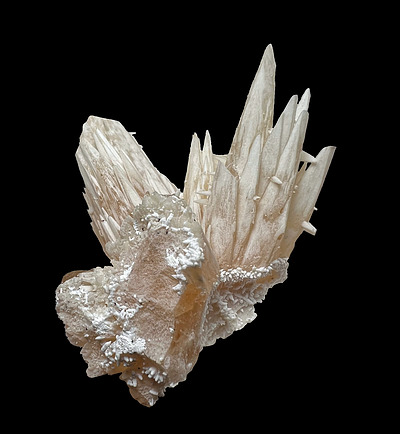Paralstonite
A valid IMA mineral species
This page is currently not sponsored. Click here to sponsor this page.
About Paralstonite
Formula:
BaCa(CO3)2
Colour:
Colorless, smoky white to pale gray
Lustre:
Vitreous
Hardness:
4 - 4½
Specific Gravity:
3.60
Crystal System:
Trigonal
Name:
Named from the Greek 'para' for near, and alstonite, for the polymorphic relationship with that mineral.
Type Locality:
Polymorph of:
Olekminskite-Paralstonite Series.
Morphologically and physically indistinguishable from alstonite. Optics, PXRD, or single crystal XRD are needed to distinguish the two species. Alstonite is biaxial negative with 2V=7deg, while paralstonite is uniaxial negative. In PXRD, the 6.12 Å line is strong in paralstonite and absent for alstonite. Also the 5.6 Å line is medium strength for paralstonite and absent for alstonite.
Morphologically and physically indistinguishable from alstonite. Optics, PXRD, or single crystal XRD are needed to distinguish the two species. Alstonite is biaxial negative with 2V=7deg, while paralstonite is uniaxial negative. In PXRD, the 6.12 Å line is strong in paralstonite and absent for alstonite. Also the 5.6 Å line is medium strength for paralstonite and absent for alstonite.
Unique Identifiers
Mindat ID:
3097
Long-form identifier:
mindat:1:1:3097:3
GUID
(UUID V4):
(UUID V4):
d86a2d57-d396-49b6-8311-d79266e49c43
IMA Classification of Paralstonite
Approved
First published:
1979
Classification of Paralstonite
5.AB.40
5 : CARBONATES (NITRATES)
A : Carbonates without additional anions, without H2O
B : Alkali-earth (and other M2+) carbonates
5 : CARBONATES (NITRATES)
A : Carbonates without additional anions, without H2O
B : Alkali-earth (and other M2+) carbonates
14.2.2.2
14 : ANHYDROUS NORMAL CARBONATES
2 : AB(XO3)2
14 : ANHYDROUS NORMAL CARBONATES
2 : AB(XO3)2
11.5.5
11 : Carbonates
5 : Carbonates of Sr and Ba
11 : Carbonates
5 : Carbonates of Sr and Ba
Mineral Symbols
As of 2021 there are now IMA–CNMNC approved mineral symbols (abbreviations) for each mineral species, useful for tables and diagrams.
| Symbol | Source | Reference |
|---|---|---|
| Pasn | IMA–CNMNC | Warr, L.N. (2021). IMA–CNMNC approved mineral symbols. Mineralogical Magazine, 85(3), 291-320. doi:10.1180/mgm.2021.43 |
Pronunciation of Paralstonite
Pronunciation:
| Play | Recorded by | Country |
|---|---|---|
| Jolyon Ralph | United Kingdom |
Physical Properties of Paralstonite
Vitreous
Transparency:
Transparent, Translucent
Colour:
Colorless, smoky white to pale gray
Hardness:
4 - 4½ on Mohs scale
Tenacity:
Brittle
Fracture:
Irregular/Uneven
Density:
3.60(2) g/cm3 (Measured) 3.62 g/cm3 (Calculated)
Optical Data of Paralstonite
Type:
Uniaxial (-)
RI values:
nω = 1.672(3) nε = 1.527(3)
Max Birefringence:
δ = 0.145

Image shows birefringence interference colour range (at 30µm thickness)
and does not take into account mineral colouration.
and does not take into account mineral colouration.
Surface Relief:
Moderate
Chemistry of Paralstonite
Mindat Formula:
BaCa(CO3)2
Elements listed:
Common Impurities:
Sr
Crystallography of Paralstonite
Crystal System:
Trigonal
Class (H-M):
3 2 - Trapezohedral
Space Group:
P3 2 1
Cell Parameters:
a = 8.692(3) Å, c = 6.148(4) Å
Ratio:
a:c = 1 : 0.707
Unit Cell V:
402.26 ų (Calculated from Unit Cell)
Z:
3
Morphology:
Crusts composed of tiny pyramidal crystals to 1 mm. Length to width ratio approaching 2:1, hexagonal morphology with {221} pyramidal habit. Hexagonal dipyramids are rare. Crystal faces are heavily striated normal to axis of elongation (c-axis) and are divided parallel to c-axis by a medial, irregular, slightly re-entrant "suture".
Twinning:
Twinning is noted (Roberts 1978).
Crystal Structure
Load
Unit Cell | Unit Cell Packed
2x2x2 | 3x3x3 | 4x4x4
Unit Cell | Unit Cell Packed
2x2x2 | 3x3x3 | 4x4x4
Show
Big Balls | Small Balls | Just Balls | Spacefill
Polyhedra Off | Si Polyhedra | All Polyhedra
Remove metal-metal sticks
Big Balls | Small Balls | Just Balls | Spacefill
Polyhedra Off | Si Polyhedra | All Polyhedra
Remove metal-metal sticks
Display Options
Black Background | White Background
Perspective On | Perspective Off
2D | Stereo | Red-Blue | Red-Cyan
Black Background | White Background
Perspective On | Perspective Off
2D | Stereo | Red-Blue | Red-Cyan
View
CIF File Best | x | y | z | a | b | c
CIF File Best | x | y | z | a | b | c
Rotation
Stop | Start
Stop | Start
Labels
Console Off | On | Grey | Yellow
Console Off | On | Grey | Yellow
Data courtesy of the American Mineralogist Crystal Structure Database. Click on an AMCSD ID to view structure
| ID | Species | Reference | Link | Year | Locality | Pressure (GPa) | Temp (K) |
|---|---|---|---|---|---|---|---|
| 0014766 | Paralstonite | Effenberger H (1980) Die kristallstruktur des minerals paralstonite, BaCa(CO3)2 Neues Jahrbuch fur Mineralogie, Monatshefte 1980 353-363 | 1980 | Cave-in-Rock District, Illinois, USA | 0 | 293 |
CIF Raw Data - click here to close
X-Ray Powder Diffraction
Powder Diffraction Data:
| d-spacing | Intensity |
|---|---|
| 3.550 Å | (100) |
| 2.510 Å | (67) |
| 2.048 Å | (21) |
| 6.15 Å | (18) |
| 1.943 Å | (18) |
| 1.853 Å | (15) |
| 4.35 Å | (11) |
Comments:
Powder pattern essentially identical to that of alstonite.
Geological Environment
Paragenetic Mode(s):
| Paragenetic Mode | Earliest Age (Ga) |
|---|---|
| Near-surface Processes | |
| 23 : Subaerial aqueous alteration by non-redox-sensitive fluids (see also #47) |
Type Occurrence of Paralstonite
Place of Conservation of Type Material:
Canadian Geological Survey, Ottawa, 13380; Royal Ontario Museum, Toronto, Canada; National Museum of Natural History, Washington, D.C., USA, 145915.
Associated Minerals at Type Locality:
Reference:
Roberts, A.C. (1979) Paralstonite: A new mineral from the Minerva No. 1 mine, Cave-in-Rock, Illinois. Geological Survey of Canada Paper 79-1C: 99-100.
Synonyms of Paralstonite
Other Language Names for Paralstonite
Relationship of Paralstonite to other Species
Forms a series with:
Common Associates
Associated Minerals Based on Photo Data:
| 5 photos of Paralstonite associated with Thomsenolite | NaCa[AlF6] · H2O |
| 5 photos of Paralstonite associated with Pachnolite | NaCa[AlF6] · H2O |
| 5 photos of Paralstonite associated with Cryolite | Na2NaAlF6 |
| 4 photos of Paralstonite associated with Calcite | CaCO3 |
| 3 photos of Paralstonite associated with Fluorite | CaF2 |
| 1 photo of Paralstonite associated with Witherite | BaCO3 |
Related Minerals - Strunz-mindat Grouping
| 5.AB. | Škáchaite | CaCo(CO3)2 |
| 5.AB.05 | Calcite | CaCO3 |
| 5.AB.05 | Gaspéite | NiCO3 |
| 5.AB.05 | Magnesite | MgCO3 |
| 5.AB.05 | Otavite | CdCO3 |
| 5.AB.05 | Rhodochrosite | MnCO3 |
| 5.AB.05 | Siderite | FeCO3 |
| 5.AB.05 | Smithsonite | ZnCO3 |
| 5.AB.05 | Spherocobaltite | CoCO3 |
| 5.AB.05 va | Parakutnohorite | |
| 5.AB.10 | Ankerite | Ca(Fe2+,Mg)(CO3)2 |
| 5.AB.10 | Dolomite | CaMg(CO3)2 |
| 5.AB.10 | Kutnohorite | CaMn2+(CO3)2 |
| 5.AB.10 | Minrecordite | CaZn(CO3)2 |
| 5.AB.15 | Aragonite | CaCO3 |
| 5.AB.15 | Cerussite | PbCO3 |
| 5.AB.15 | Strontianite | SrCO3 |
| 5.AB.15 | Witherite | BaCO3 |
| 5.AB.20 | Vaterite | CaCO3 |
| 5.AB.25 | Huntite | CaMg3(CO3)4 |
| 5.AB.30 | Norsethite | BaMg(CO3)2 |
| 5.AB.35 | Alstonite | BaCa(CO3)2 |
| 5.AB.40 | Olekminskite | Sr(Sr,Ca,Ba)(CO3)2 |
| 5.AB.45 | Barytocalcite | BaCa(CO3)2 |
| 5.AB.50 | Carbocernaite | (Ca,Na)(Sr,Ce,Ba)(CO3)2 |
| 5.AB.55 | Benstonite | Ba6Ca6Mg(CO3)13 |
| 5.AB.60 | Juangodoyite | Na2Cu(CO3)2 |
Fluorescence of Paralstonite
Fluoresces pale to bright orange under LW UV.
Other Information
Notes:
Vigorous effervescence in dilute HCl.
Health Risks:
No information on health risks for this material has been entered into the database. You should always treat mineral specimens with care.
Internet Links for Paralstonite
mindat.org URL:
https://www.mindat.org/min-3097.html
Please feel free to link to this page.
Please feel free to link to this page.
Search Engines:
External Links:
Mineral Dealers:
References for Paralstonite
Reference List:
Fleischer, Michael, Burns, Roger G., Cabri, Louis J., Chao, George Y., Hogarth, D. D., Pabst, Adolf (1979) New Mineral Names. American Mineralogist, 64 (11-12) 1329-1334
Fleischer, Michael, Chao, George Y., Francis, Carl A., Pabst, and Adolf (1981) New Mineral Names. American Mineralogist, 66 (1-2) 217-220
Localities for Paralstonite
Locality List
 - This locality has map coordinates listed.
- This locality has map coordinates listed.
 - This locality has estimated coordinates.
ⓘ - Click for references and further information on this occurrence.
? - Indicates mineral may be doubtful at this locality.
- This locality has estimated coordinates.
ⓘ - Click for references and further information on this occurrence.
? - Indicates mineral may be doubtful at this locality.
 - Good crystals or important locality for species.
- Good crystals or important locality for species.
 - World class for species or very significant.
(TL) - Type Locality for a valid mineral species.
(FRL) - First Recorded Locality for everything else (eg varieties).
- World class for species or very significant.
(TL) - Type Locality for a valid mineral species.
(FRL) - First Recorded Locality for everything else (eg varieties).
All localities listed without proper references should be considered as questionable.
Canada | |
| Canadian Museum of Nature collection |
China | |
| Zhang Peishan et al. (1996) |
New Zealand | |
| Cooper et al. (2008) |
| Woolley (2019) |
Russia | |
| [Lapis 1993:4 p.13-20] |
| Pekov (1998) | |
| Sorokhtina et al. (2008) |
| Sharygin et al. (2008) |
UK | |
| T.F. Cotterell : "The mineralogy of ... +1 other reference |
USA | |
| Mineralogical Record |
| A. C. Roberts (1979) +1 other reference |
| Mineralogical Record (1997) |
Quick NavTopAbout ParalstoniteUnique IdentifiersIMA Classification Classification Mineral SymbolsPronunciation Physical Properties Optical Data Chemistry Crystallography Crystal StructureX-Ray Powder DiffractionGeological EnvironmentType Occurrence SynonymsOther LanguagesRelationshipsCommon AssociatesStrunz-MindatFluorescence Other InformationInternet Links References Localities Locality List







 symbol to view information about a locality.
The
symbol to view information about a locality.
The 



Dolyhir Quarry, Old Radnor, Powys, Wales, UK